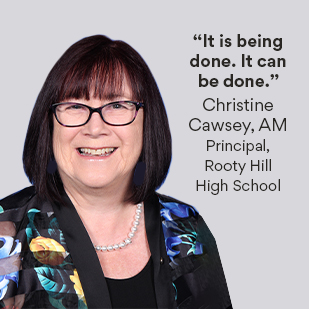“It is being done. It can be done.”
The case for school-business partnering is strong, with multiple student benefits. Working directly together or with other experts, school-business partnering can bring to life one or more benefits in new and interesting ways at any stage of education.
- Improving learning - new knowledge, skills, capabilities and dispositions
- Inspiring possibilities – considering new choices and/or directions, lifting ambitions
- Building confidence – pursuing ideas, passions, leadership aspirations
- Enabling greater participation – pursuing career ambitions, autonomy, equity and co-designed learning
- Becoming empathetic – new and deepening understandings of stereotypes and barriers to social connectedness
- Broadening connections – accessing new expertise, building new networks
- Deepening engagement – positive associations with school and work, putting in the effort
Benefits for students can also have a flow-on effect for adults (e.g. mentoring students can challenge people from business in new ways of thinking and improve their communication skills while helping students do the same). There are also wider and personal reasons schools and businesses want and need to be partnering. Shaping the context for Australian students are challenges and disruptors. These include deepening inequities in the education experience, a rapidly changing job market, and recognition that students rightfully want a say in the educational choices that affect their present and future.
Engaging together for impact
Once a school decides to connect with business, they can set the stage for partnering beyond involving business in activities to intentionally engaging with business for impact. Partnering preparation fundamentals are:
- There is an evidenced student need or opportunity. Who are the students and families and what are their lives like? What will change by engaging with business?
- Visible values, principles and priorities guide ‘the what’ (focus) and ‘the how’ (the relationship) of partnering.
- All connections require school leadership commitment, effort, expertise, resourcing and a degree of coordination for sustainability.
Every partnering lifecycle will involve three continuous phases:
- Emerging: Scoping who to connect with and in what ways can be an early hurdle to overcome.
- Executing: Both educational and business leaders recognise a child’s understanding of self-worth, working with others, and work and careers begins early. Students benefit from exposure to multiple meaningful experiences and opportunities across every educational stage.
- Embedding: Leaders pay attention to why and how to build and measure partnering cultures.
Download the Purposeful Partnering Summary for Schools for more information, including examples of benefits and practice tips.
Explore tools, tips and connections to help you on your partnering journey.


